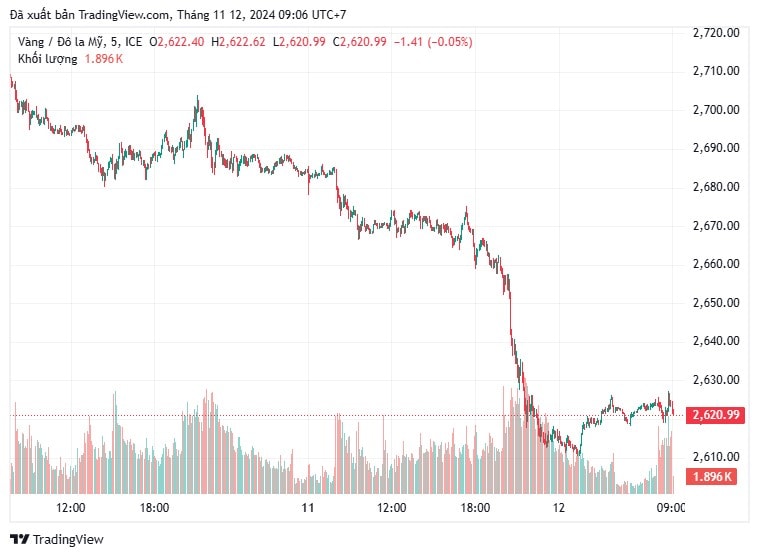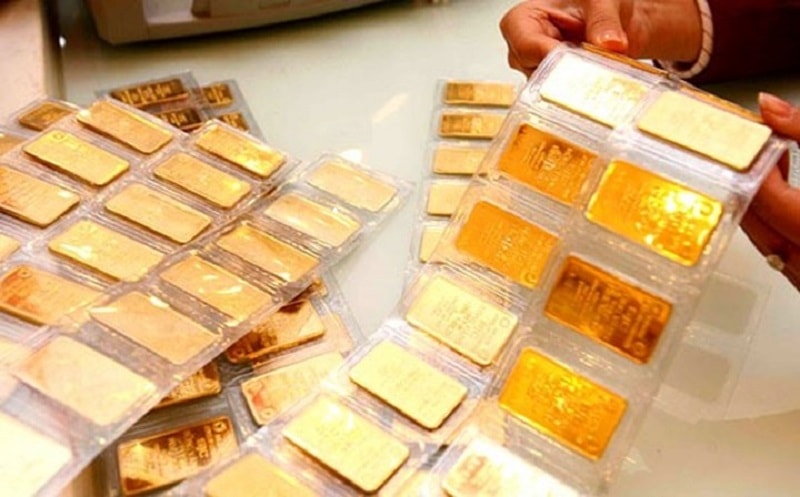What happens next after gold prices have plummeted?
In the morning trading session on November 12, gold prices continued to drop significantly both in the global and domestic markets. Experts predict that gold prices may decline further.
As of 9 a.m. on November 12 (Vietnam time), global gold prices hovered around $2,620 per ounce, down nearly $62 per ounce compared to the same time yesterday.

Today’s gold price plunge comes amid a rise in the USD Index, which reached 105.5 points, pushing the dollar to its highest level in over four months. This trend reflects investor expectations that U.S. fiscal and interest rate policies may face pressure following Donald Trump’s election as President.
Additionally, crude oil prices dropped sharply to $68 per barrel, while the U.S. stock market remained positive, sparking investor interest in fuel and stock markets. This shift in focus reduced inflows into precious metals, adding downward pressure on today’s gold price.
Moreover, investors are concerned about a drop in gold demand from China, as the country's central bank has halted gold purchases for the sixth consecutive month. Many investors sold gold to secure profits, further driving today’s gold prices down.
Looking ahead, most experts agree that gold prices will continue to decline. David Morrison, a senior market analyst at Trade Nation, noted that technical indicators show gold is still in a downward trend. Last week’s sell-off was driven by a strong U.S. dollar and rising bond yields. According to Morrison, even further rate cuts by the Federal Reserve may not be enough to lift gold prices.
Similarly, Frank Sohlleder, an analyst at Activ Trades, predicts that gold prices are likely to continue declining in the near term, with the precious metal facing challenges in avoiding further downturns.
On the other hand, Marc Chandler, Managing Director of Bannockburn Global Forex, suggests that if gold prices drop to $2,600 per ounce, it may present an opportunity for investors to “catch the bottom,” potentially making gold attractive again.
Adrian Day, Chairman of Adrian Day Asset Management, forecasts that the decline could last about six weeks. However, he anticipates medium- to long-term buying interest to increase. Many central banks are still looking to diversify their assets with gold to reduce reliance on the U.S. dollar. The Fed and other central banks may continue loosening monetary policies, creating potential for gold to appreciate in the future.

In the domestic market, as trading opened this morning, nearly all gold businesses sharply reduced prices for both SJC gold bars and gold jewelry.
At 9 a.m., SJC gold bars at Saigon Jewelry Company (SJC) dropped by 1,300,000 VND per tael in both buying and selling transactions from the previous day’s closing price, reaching 80,600,000 VND per tael for buying and 84,100,000 VND per tael for selling.
Similarly, SJC gold bars at DOJI were reduced in both major markets, Hanoi and Ho Chi Minh City, by 1,300,000 VND per tael in both buying and selling transactions from the previous day’s close, now priced at 80,600,000 VND per tael for buying and 84,100,000 VND per tael for selling.
Phu Quy SJC listed SJC gold bars at 80,800,000 VND per tael for buying and 84,100,000 VND per tael for selling, down by 1,300,000 VND per tael from the November 11 close.
Bao Tin Minh Chau also applied the buying price of 80,800,000 VND per tael and the selling price of 84,100,000 VND per tael in this morning’s session, down 1,300,000 VND per tael in both buying and selling from the previous closing session.
Likewise, PNJ brand jewelry gold from Phu Nhuan Jewelry (PNJ) saw a sharp decrease of 1,500,000 VND per tael in both buying and selling from the November 11 close. PNJ now lists jewelry gold at 81,600,000 VND per tael for buying and 83,400,000 VND per tael for selling in both Hanoi and Ho Chi Minh City markets.








